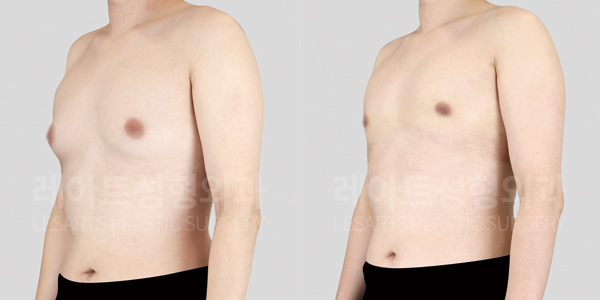Post-Operative Care for Male Chest Surgery (Gynecomastia Surgery)

Information
- Age : early 40’s
- Height : 183cm
- Weight : 81kg
- BMI : 24
Surgical site
- surgical site : gynecomastia
- grade : 2-B
Gynecomastia is one of the conditions that many men have, more than expected. It often begins as an aesthetic issue but can ultimately cause discomfort in daily life and psychological burdens.
Especially in cases where the cause is overdevelopment of glandular tissue, weight loss or chest exercises won’t improve gynecomastia symptoms, which leads many to consider surgery.
Gynecomastia surgery works by removing the glandular tissue to reduce the chest size and, if necessary, eliminating the excess fat that contributes to the chest volume through liposuction. This procedure can naturally improve the shape of the chest.
Many patients undergoing gynecomastia surgery not only treat the condition but also regain their confidence.
However, after gynecomastia surgery, proper post-operative care is essential to maintain satisfactory results.
For example, side effects such as swelling or sensory loss may occur as part of the natural recovery process, but it’s important to have a clear understanding and management of these symptoms.
Therefore, proper use of compression garments, regular follow-up checks, and wound care for scars are crucial.
With careful attention to these aspects, more natural and balanced results can be expected after surgery.
Let’s take a closer look at the before-and-after photos of a patient’s gynecomastia surgery and analyze the treatment results in detail.

[Lesarts plastic surgery body assessment before gynecomastia surgery]
This patient is in his early 40s and has had gynecomastia since his teenage years, noticing protrusion around the areola and an overall increase in chest size.
Despite no significant weight changes, he experienced an increase in chest size, which led to ongoing discomfort in daily life.
As a result, he sought to correct the shape of his chest through gynecomastia surgery and visited several hospitals to receive a diagnosis. He then came to our clinic to receive more professional consultation and a personalized treatment plan.
For this patient, whether his health insurance would cover the surgery was also an important consideration. He underwent multiple ultrasound exams to get an accurate diagnosis and consultation.
Ultimately, based on his trust in our clinic’s expertise and the expected results, he decided to proceed with the gynecomastia surgery.

[Lesarts plastic surgery body assessment before gynecomastia surgery]
Before the gynecomastia surgery, we thoroughly checked the patient’s symptoms.
Visually, we observed that the overall size of the chest had increased, with noticeable protrusion. After performing an ultrasound for a more accurate diagnosis, we confirmed the overgrowth of the glandular tissue.
The medical team diagnosed the patient’s condition as true gynecomastia, corresponding to Simon Grade 2B.
As a result, we explained that simple exercise or just liposuction would not be sufficient to reduce the size of the enlarged chest, and that glandular tissue removal (mastectomy) would be necessary.
Additionally, to prevent any collapse or indentation in the chest shape after the glandular tissue is removed, we planned to perform tissue rearrangement surgery to maintain a more natural and firm chest contour.
Furthermore, the patient had some skin laxity corresponding to Simon Grade 2B, and the skin appeared stretched.
We advised the patient to wear the compression garment more carefully after the surgery to prevent sagging and emphasized the importance of consistent aftercare and follow-up visits.
Below are the before and one-month post-surgery comparison photos of the patient.

[Lesarts plastic surgery before&after gynecomastia surgery(Taken under the same conditions 1 months after gynecomastia surgery.)]

[Lesarts plastic surgery before&after gynecomastia surgery(Taken under the same conditions 1 months after gynecomastia surgery.)]
Looking at the medical photos taken one month after the male gynecomastia surgery, we can see that the enlarged breast size and the protruding areola, caused by the overgrowth of glandular tissue before surgery, have been corrected through the gynecomastia surgery. The chest now appears flatter and more balanced.
In particular, the previously swollen areola has now taken on a more natural shape after the surgery.
The side and upper chest areas have also been improved to appear flat and well-balanced, with a natural curve resembling the results of chest exercises.

[1 month post-gynecomastia progress(Image for better understanding.)]

[1 month post-gynecomastia progress(Image for better understanding.)]
Even when comparing the before-and-after photos of the surgery while wearing a white T-shirt, you can clearly see the difference. Before the surgery, the areola area was protruding, giving the appearance of sagging, which was noticeable in the T-shirt fit. However, after the gynecomastia surgery and the removal of the glandular tissue, the breast size was reduced and the appearance became more natural and streamlined.
The patient experienced some swelling and sensory numbness in the left chest area shortly after the surgery, but we reassured the patient that these were temporary symptoms. These sensations gradually eased and disappeared. However, if the discomfort worsens or if there are abnormal sensations, we instructed the patient to contact the hospital and come for a follow-up.
We also emphasized the importance of wearing compression garments and carefully managing the scars.
The recovery process after gynecomastia surgery can vary from person to person, and many patients may feel concerned about the initial post-surgery symptoms. However, differences in recovery speed or post-surgery symptoms are normal, and as long as the patient follows the medical team’s instructions and pays attention to care, stable and satisfying results can be expected.
As mentioned earlier, there may be some swelling or sensory changes in the early stages after surgery, but it is important not to worry too much. Through consistent care and regular follow-up visits, a more natural and satisfying outcome can be achieved.